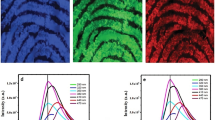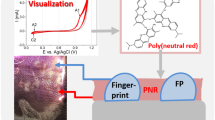Abstract
The aim of this chapter is to comprehensively review the application of the principles of reduction-oxidation reactions, electrochemistry and electrochemical-based techniques to the visualization of latent fingermarks and to study their physical and chemical modifications over time.
After a brief introduction, the first part discusses redox reactions, which are at the basis of both well-established latent fingermarks detection techniques as well as innovative and very promising procedures that need yet to be fully explored for their application in casework. These redox reactions are typically exploited to in situ synthesise the enhancement reactant. Generally, this reactant selectively adheres to the print residue, leading to the positive development of the mark. Examples of these procedures include the physical developer (PD) and the processes based on colloidal gold, i.e. multimetal deposition (MMD) and its subsequently modified versions like MMD II and single-metal deposition (SMD and SMD II). The selective deposition of the reactant to the fingermark ridges can be then exploited by scanning electrochemistry microscopy (SECM) for imaging purposes. Another option for the enhancement reactant is to be directed towards the regions of the substrate free from the fingermark, thus enhancing the furrows rather than the ridges and leading to the so-called inverse development. Examples of this approach include electrodeposition and electrophoretic deposition. The ability of the fingermark residue to act as a mask towards an underlying metal substrate is also at the basis of differential corrosion approaches.
The sensitivity of electrochemical techniques in monitoring the physical changes that a fingermark undergoes over time will be highlighted in the second part of the chapter. Indeed, the possibility to concurrently monitor physical modifications and the variation in the chemical composition represents a highly desirable added value in order to reach trustworthy information of time since deposition.
Most techniques that record physical modifications of fingermarks over time are based on microscopy observations, thus significantly limiting the sensitivity of detectable changes and easily exposing the results to certain bias from the observer. However, electrochemical-based techniques possess the potential to overcome the limits inherent to microscopy observations and allows a deeper understanding of the complex mechanisms involved in the aging of fingermarks. The application of electrochemical impedance spectroscopy (EIS) and the use of an electric potential sensor (EPS) for imaging surface charges and monitoring their decay will be illustrated in this section.
Finally, concluding remarks will highlight the yet unexplored potentialities of electrochemistry to the discipline of latent fingermarks research, including both visualization and age determination possibilities.
Access this chapter
Tax calculation will be finalised at checkout
Purchases are for personal use only
Similar content being viewed by others
Abbreviations
- PD:
-
Physical developer
- MMD:
-
Multimetal deposition
- SMD:
-
Single-metal deposition
- SECM:
-
Scanning electrochemistry microscopy
- EIS:
-
Electrochemical impedance spectroscopy
- EPS:
-
Electric potential sensor
- GSRs:
-
Gunshot residues
- ELD:
-
Electrolytic deposition
- EPD:
-
Electrophoretic deposition
- CNLS:
-
Complex non-linear least squares
- CPE:
-
Constant phase element
- GC:
-
Glassy carbon
- PTFE:
-
Polytetrafluoroethylene
References
Bard AJ, Faulkner LR (2001) Electrochemical methods – fundamentals and applications, 2nd edn. Wiley, New York
Yu HA, DeTata DA, Lewis SW, Silvester DS (2017) Recent developments in the electrochemical detection of explosives: towards field-deployable devices for forensic science. Trends Anal Chem 97:374–384
Trejos T, Pyl CV, Menking-Hoggatt K, Alvarado AL, Arroyo LE (2018) Fast identification of inorganic and organic gunshot residues by LIBS and electrochemical methods. Forensic Chem 8:146–156
Florea A, de Jong M, De Wael K (2018) Electrochemical strategies for the detection of forensic drugs. Curr Opin Electrochem 11:34–40
Mendes LF, e Silva ARS, Bacil RP, Serrano SHP, Angnes L, Paixao TRLC, de Araujo WR (2019) Forensic electrochemistry: electrochemical study and quantification of xylazine in pharmaceutical and urine samples. Electrochim Acta 295:726–734
de Oliveira LP, Rocha DP, de Araujo WR, Munoz RAA, Paixao TRLC, Salles MO (2018) Forensic in hand: new trends in forensic devices (2013–2017). Anal Methods 10:5135–5163
Ferreira PC, Ataide VN, Chagas CLS, Angnes L, Coltro WKT, Paixao TRLC, de Araujo WR (2019) Wearable electrochemical sensors for forensic and clinical applications. Trends Anal Chem 119:115622
Ramotowski RS (2013, Ch. 3) Metal deposition methods. In: Ramotowski RS (ed) Lee and Gaensslen’s advances in fingerprint technology, 3rd edn. CRC Press, Boca Raton, pp 55–81
Moenssen AA (1971) Fingerprint techniques. Chilton Book Company, Radnor. p. 120
Morris JR, Wells JM (1979) British Patent: 154014
Sodhi GS, Kaur J (2016) Physical developer method for detection of latent fingerprints: a review. Egypt J Forensic Sci 6:44–47
Cantu A, Johnson J (2001) Silver physical development of latent prints. In: Advances in fingerprint technology, 2nd edn. CRC Press, Boca Raton
de la Hunty M, Moret S, Chadwick S, Lennard C, Spindler X, Roux C (2015) Understanding physical developer (PD): part I – is PD targeting lipids? Forensic Sci Int 257:481–487
de la Hunty M, Moret S, Chadwick S, Lennard C, Spindler X, Roux C (2015) Understanding physical developer (PD): part II – is PD targeting eccrine constituents? Forensic Sci Int 257:488–495
Mohamed AA (2011) Gold is going forensic. Gold Bull 44:71–77
Saunders G (1989) Multimetal deposition technique for latent fingerprint development. Presented at the International Association for Identification, 74th Annual Education Conference, 1989, Pensacola, USA
Wuithschick M, Birnbaum A, Witte S, Sztucki M, Vainio U, Pinna N, Rademann K, Emmerling F, Kraehnert R, Polte J (2015) Turkevich in new robes: key questions answered for the most common gold nanoparticle synthesis. ACS Nano 9:7052–7071
Becue A, Scoundrianos A, Moret S (2012) Detection of fingermarks by colloidal gold (MMD/SMD) – beyond the pH 3 limit. Forensic Sci Int 219:39–49
Schnetz B, Margot P (2001) Technical note: latent fingermarks, colloidal gold and multimetal deposition (MMD) – optimisation of the method. Forensic Sci Int 118:21–28
Slot JW, Geuze HJ (1985) A new method of preparing gold probes for multiple-labelling cytochemistry. Eur J Cell Biol 38:87–93
Stauffer E, Becue A, Singh KV, Thampi KR, Champod C, Margot P (2007) Single-metal deposition (SMD) as a latent fingermark enhancement technique: an alternative to multimetal deposition (MMD). Forensic Sci Int 168:e5–e9
Durussel P, Stauffer E, Becue A, Champod C, Margot P (2009) Single-metal deposition: optimization of this fingermark enhancement technique. J Forensic Identif 59:80–96
Moret S, Becue A (2015) Single-metal deposition for fingermark detection – a simpler and more efficient protocol. J Forensic Identif 65:118–137
Newland TG, Moret S, Becue A, Lewis SW (2016) Further investigations into the single metal deposition (SMD II) technique for the detection of latent fingermarks. Forensic Sci Int 268:62–72
Moret S, Lee PLT, de la Hunty M, Spindler X, Lennard C, Roux C (2019) Single metal deposition versus physical developer: a comparison between two advanced fingermark detection techniques. Forensic Sci Int 294:103–112
Zhang M, Girault HH (2007) Fingerprint imaging by scanning electrochemical microscopy. Electrochem Commun 9:1778–1782
Zhang M, Becue A, Prudent M, Champod C, Girault HH (2007) SECM imaging of MMD-enhanced latent fingermarks. Chem Commun 38:3948–3950
Zhang M, Girault HH (2009) SECM for imaging and detection of latent fingerprints. Analyst 134:25–30
Bond JW (2008) Visualization of latent fingerprint corrosion of metallic surfaces. J Forensic Sci 53:812–822
Bond JW (2009) Visualization of latent fingerprint corrosion of brass. J Forensic Sci 54:1034–1041
Wightman G, O’Connor D (2011) The thermal visualization of latent fingermarks on metallic surfaces. Forensic Sci Int 204:88–96
Bond JW (2011) Optical enhancement of fingerprint deposits on brass using digital colour map**. J Forensic Sci 56:1285–1288
Wightman G, Emery F, Austin C, Andersson I, Harcus L, Arju G, Steven C (2015) The interaction of fingermark deposits on metal surfaces and potential ways for visualization. Forensic Sci Int 249:241–254
Song DF, Sommerville D, Brown AG, Shimmon RG, Reedy BJ, Tahtouh M (2011) Thermal development of latent fingermarks on porous surfaces – further observations and refinements. Forensic Sci Int 204:97–110
Rosa R, Veronesi P, Leonelli C (2013) Microwave selective thermal development of latent fingerprints on porous surfaces: potentialities of the method and preliminary experimental results. J Forensic Sci 58:1314–1321
Choi MJ, McDonagh AM, Maynard P, Roux C (2008) Metal containing nanoparticles and nano-structured particles in fingermark detection. Forensic Sci Int 179:87–97
Dilag J, Kobus HJ, Ellis AV (2011) Nanotechnology as a new tool for fingermark detection: a review. Curr Nanosci 7:153–159
Hazarika P, Russell DA (2012) Advances in fingerprint analysis. Angew Chem Int Ed 51:3524–3531
Becue A, Cantu AA (2013) Fingermark detection using nanoparticles. In: Ramotowsky RS (ed) Lee and Gaensslen’s advances in fingerprint technology, 3rd edn. CRC Press, Taylor & Francis Group, Boca Raton, pp 307–379
Spindler X, Hofstetter O, McDonagh AM, Roux C, Lennard C (2011) Enhancement of latent fingermarks on non-porous surfaces using anti-L-amino acid antibodies conjugated to gold nanoparticles. Chem Commun 47:5602–5604
Wood M, Maynard P, Spindler X, Lennard C, Roux C (2012) Visualization of latent fingermarks using an aptamer-based reagent. Angew Chem Int Ed 51:12272–12274
He Y, Xu L, Zhu Y, Wei Q, Zhang M, Su B (2014) Immunological multimetal deposition for rapid visualization of sweat fingerprints. Angew Chem Int Ed 53:12609–12612
Moret S, Spindler X, Lennard C, Roux C (2015) Microscopic examination of fingermark residues: opportunities for fundamentals studies. Forensic Sci Int 255:28–37
Jaber N, Lesniewski A, Gabizon H, Shenawi S, Mandler D, Almog J (2012) Visualization of latent fingermarks by nanotechnology: reversed development on paper – a remedy to the variation in sweat composition. Angew Chem Int Ed 51:12224–12227
Qin G, Zhang M, Zhang Y, Zhu Y, Liu S, Wu W, Zhang X (2013) Visualizing latent fingerprints by electrodeposition of metal nanoparticles. J Electroanal Chem 693:122–126
Qin G, Zhang M, Zhang Y, Zhu Y, Liu S, Wu W, Zhang X (2013) Visualization of latent fingerprints using Prussian blue thin films. Chin Chem Lett 24:173–176
Bersellini C, Garofano L, Giannetto M, Lusardi F, Mori G (2001) Development of latent fingerprints on metallic surfaces using electropolymerization processes. J Forensic Sci 46:871–877
Beresford AL, Hillman AR (2010) Electrochromic enhancement of latent fingerprints on stainless steel surfaces. Anal Chem 82:483–486
Brown RM, Hillman AR (2012) Electrochromic enhancement of latent fingerprints by poly(3,4-ethylenedioxythiophene). Phys Chem Chem Phys 14:8653–8661
Sapstead RM, Ryder KS, Fullarton C, Skoda M, Dalgliesh RM, Watkins EB, Beebee C, Barker R, Glidle A, Hillman AR (2013) Nanoscale control of interfacial processes for latent fingerprint enhancement. Faraday Discuss 164:391–410
Rosa R, Cannio M, Veronesi P, Leonelli C (2013) Electrophoretic deposition of nanoparticles and nano-structured particles for latent fingerprints detection on different surfaces. Proceedings of the 65th Annual Scientific Meeting of the American Academy of Forensic Sciences, February 18–23, 2013, Washington, DC, USA, vol 19, pp 30–31
Corni I, Ryan MP, Boccaccini AR (2008) Electrophoretic deposition: from traditional ceramics to nanotechnology. J Eur Ceram Soc 28:1353–1367
Zetasizer Nano User Manual, MAN0317, issue 4.0, Malvern Instruments, Worcestershire, UK, May 2008
Rosa R, Veronesi P, Leonelli C (2014) Strengthening research methodology for new latent fingerprints development techniques by means of design of experiments (DoE). Proceedings of the 66th Annual Scientific Meeting of the American Academy of Forensic Sciences, Seattle, WA, USA, February 17–22, 2014, vol 20, pp 87–88
Girod A, Ramotowski R, Weyermann C (2012) Composition of fingermark residue: a qualitative and quantitative review. Forensic Sci Int 223:10–24
Sears VG, Bleay SM, Bandey HL, Bowman VJ (2012) A methodology for finger mark research. Sci Justice 52:145–160
van Asten AC (2014) On the added value of forensic science and grand innovation challenges for the forensic community. Sci Justice 54:170–179
Archer NE, Charles Y, Elliot JA, Jickells S (2005) Changes in the lipid composition of latent fingerprint residues with time after deposition on a surface. Forensic Sci Int 154:224–239
Weyermann C, Roux C, Champod C (2011) Initial results on the composition of fingerprints and its evolution as a function of time by GC/MS analysis. J Forensic Sci 56:102–108
Croxton RS, Baron MG, Butler D, Kent T, Sears VG (2006) Development of a GC-MS method for the simultaneous analysis of latent fingerprint components. J Forensic Sci 51:1329–1333
Croxton RS, Baron MG, Butler D, Kent T, Sears VG (2010) Variation in amino acid and lipid composition of latent fingerprints. Forensic Sci Int 199:93–102
Girod A, Pyratou A, Holmes D, Weyermann C (2016) Aging of target lipid parameters in fingermark residue using GC/MS: effects of influence factors and perspectives for dating purposes. Sci Justice 56:165–180
Girod A, **ao L, Reedy B, Roux C, Weyermann C (2015) Fingermark initial composition and aging using Fourier transform infrared microscopy (μ-FTIR). Forensic Sci Int 254:185–196
Barros RM, Faria BEF, Kuckelhaus SAS (2013) Morphometry of latent palmprints as a function of time. Sci Justice 53:402–408
Popa G, Potorac R, Preda N (2010) Method for fingerprint age determination. Rom J Legal Med 2:149–154
Merkel R, Gruhn S, Dittmann J, Vielhauer C, Brautigam A (2012) On non-invasive 2D and 3D chromatic white light image sensors for age determination of latent fingerprints. Forensic Sci Int 222:52–70
De Alcaraz-Fossoul J, Patris CM, Muntaner AB, Feixat CB, Badia MG (2013) Determination of latent fingerprint degradation patterns – a real fieldwork study. Int J Legal Med 127:857–870
De Alcaraz-Fossoul J, Patris CM, Feixat CB, McGarr L, Brandelli D, Stow K, Badia MG (2016) Latent fingermark aging patterns (part I): minutiae count as one indicator of degradation. J Forensic Sci 61:322–333
De Alcaraz-Fossoul J, Feixat CB, Tasker J, McGarr L, Stow K, Carreras-Marin C, Oset JT, Badia MG (2016) Latent fingermark aging patterns (part II): color contrast between ridges and furrows as one indicator of degradation. J Forensic Sci 61:947–958
De Alcaraz-Fossoul J, Feixat CB, Carreras-Marin C, Tasker J, Zapico SC, Badia MG (2017) Latent fingermark aging patterns (part III): discontinuity index as one indicator of degradation. J Forensic Sci 62:1180–1187
De Alcaraz-Fossoul J, Feixat CB, Zapico SC, McGarr L, Carreras-Marin C, Tasker J, Badia MG (2019) Latent fingermark aging patterns (part IV): ridge width as one indicator of degradation. J Forensic Sci 64:1057–1066
De Alcaraz-Fossoul J, Mancenido M, Soignard E, Silverman N (2019) Application of 3D imaging technology to latent fingermark aging studies. J Forensic Sci 64:570–576
Bremmer RH, Nadort A, van Leeuwen TG, van Gemert MJC, Aalders MCG (2011) Age estimation of blood stains by hemoglobin derivative determination using reflectance spectroscopy. Forensic Sci Int 206:166–171
Li B, Beveridge P, O’Hare WT, Islam M (2013) The age estimation of blood stains up to 30 days old using visible wavelength hyperspectral image analysis and linear discriminant analysis. Sci Justice 53:270–277
van Dam A, Schwarz JCV, de Vos J, Siebes M, Sijen T, van Leeuwen TG, Aalders MCG, Lambrechts SAG (2014) Oxidation monitoring by fluorescence spectroscopy reveals the age of fingermarks. Angew Chem Int Ed 53:6272–6275
Lambrechts SAG, van Dam A, de Vos J, van Weert A, Sijen T, Aalders MCG (2012) On the autofluorescence of fingermarks. Forensic Sci Int 222:89–93
Rosa R, Giovanardi R, Bozza A, Veronesi P, Leonelli C (2017) Electrochemical impedance spectroscopy: a deeper and quantitative insight into the fingermarks physical modifications over time. Forensic Sci Int 273:144–152
De Alcaraz-Fossoul J, Roberts KA, Feixat CB, Hogrebe GG, Badia MG (2016) Fingermark ridge drift. Forensic Sci Int 258:26–31
Botelho EC, Scherbakoff N, Rezende MC (2001) Porosity control in glassy carbon by rheological study of the furfuryl resin. Carbon 39:45–52
Fuhrmann J (1978) Contact electrification of dielectric solids. J Electrost 4:109–118
Diaz AF, Felix-Navarro RM (2004) A semi-quantitative tribo-electric series for polymeric materials: the influence of chemical structure and properties. J Electrost 62:277–290
Lowell J, Akande AR (1988) Contact electrification-why is it variable? J Phys D Appl Phys 21:125–137
Beardsmore-Rust ST, Watson P, Prance RJ, Harland CJ, Prance H (2009) Imaging of charge spatial density on insulating materials. Meas Sci Technol 20:095711. (6 pp)
Watson P, Prance RJ, Beardsmore-Rust ST, Prance H (2011) Imaging electrostatic fingerprints with implications for a forensic timeline. Forensic Sci Int 209:e41–e45
Author information
Authors and Affiliations
Corresponding author
Editor information
Editors and Affiliations
Rights and permissions
Copyright information
© 2021 Springer Nature Switzerland AG
About this chapter
Cite this chapter
Rosa, R., Mugoni, C., Bononi, M., Giovanardi, R. (2021). Latent Fingermarks and Electrochemistry: Possibilities for Development and Aging Studies. In: De Alcaraz-Fossoul, J. (eds) Technologies for Fingermark Age Estimations: A Step Forward. Springer, Cham. https://doi.org/10.1007/978-3-030-69337-4_9
Download citation
DOI: https://doi.org/10.1007/978-3-030-69337-4_9
Published:
Publisher Name: Springer, Cham
Print ISBN: 978-3-030-69336-7
Online ISBN: 978-3-030-69337-4
eBook Packages: Law and CriminologyLaw and Criminology (R0)




